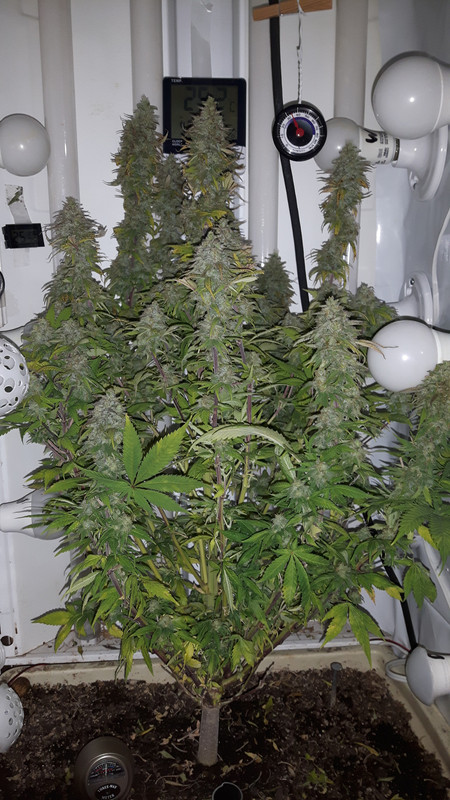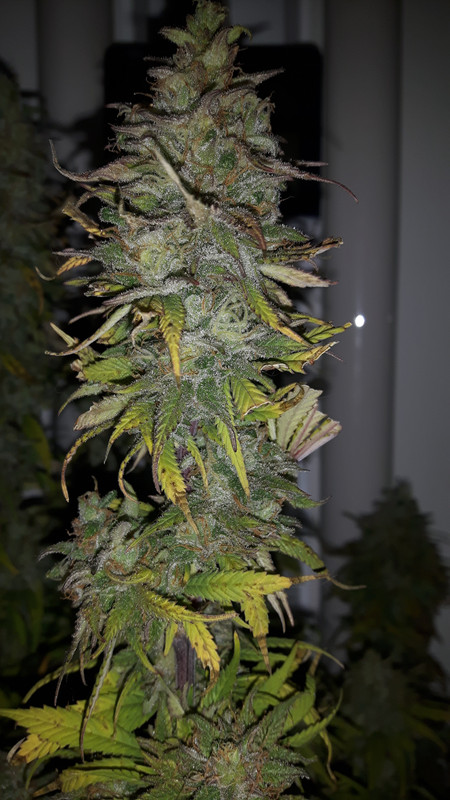-
ICMag with help from Phlizon, Landrace Warden and The Vault is running a NEW contest for Christmas! You can check it here. Prizes are: full spectrum led light, seeds & forum premium access. Come join in!
You are using an out of date browser. It may not display this or other websites correctly.
You should upgrade or use an alternative browser.
You should upgrade or use an alternative browser.
Diary PCBuds mini-grow
- Thread starter PCBuds
- Start date
StillOvergrowin
Member
My 26, 11" LED strips arrived today.
Yee Haw !!
https://postimg.cc/ZC12w6KxView Image
I can't install them until my current plant is finished though.
That should be in a week or two.
I'm debating on waiting for my heat-conducting tape arrives and sticking them to heat sinks/wall spacers/cookie sheets.
https://postimg.cc/XpyDBXcGView Image
I'm just asking...do you actually need the tape?? I was under the impression that the "panel?\ aluminum channel/cookie sheet was the heat sink. Will some Arctic paste do the same thing for less $$$?
Or is the strip itself a heatsink??

I've made a few lights using the strips. I use strips with two lines of 24 diodes each. Samsung lm561b or equivalents. Price beats anything you can buy for the same effectiveness. I also do smaller 150w 2x 50v Luminus cobs and I run similar adjustable voltage drivers but made by meanwell. $24 on amazon.
Hookahhead
Active member
I'm just asking...do you actually need the tape?? I was under the impression that the "panel?\ aluminum channel/cookie sheet was the heat sink. Will some Arctic paste do the same thing for less $$$?
Or is the strip itself a heatsink??
The tape is just double sided tape that is thermally conductive. Something like silver thermal paste that you would use in computers doesn’t have any “hold”.
PCBuds
Well-known member
I've made a few lights using the strips. I use strips with two lines of 24 diodes each. Samsung lm561b or equivalents. Price beats anything you can buy for the same effectiveness. I also do smaller 150w 2x 50v Luminus cobs and I run similar adjustable voltage drivers but made by meanwell. $24 on amazon.
My one-foot strips (11" actually) have one line of 56 LED segments.

I posted this question in the LED section and I thought I might ask you.
I watched a bunch of led Gardner videos and I've come up with my plan.
I've got 26 one foot neutral white Bridgelux Gen2 strips arriving tomorrow.
I'm going to hook them all up in parallel using my 24 V adjustable, constant voltage power supply.
I'm mounting them horizontally on all four walls with six rows from top to bottom and use them as side lighting.
I'm not going to use heat sinks. I'll space them about 1/2" off the walls.
They won't be able to be anywhere near fully cranked so I won't need to worry about maximum voltage or current.
The only parameter I want to watch very closely is my temperature.
Which leads to my question.
How do you use the temperature test point?
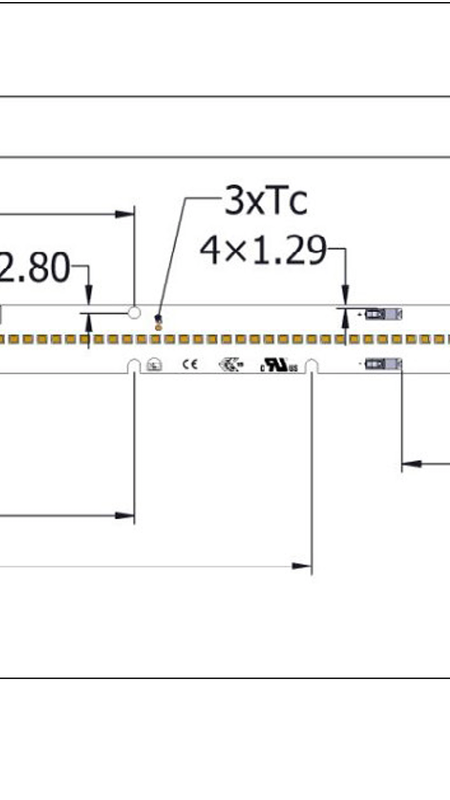

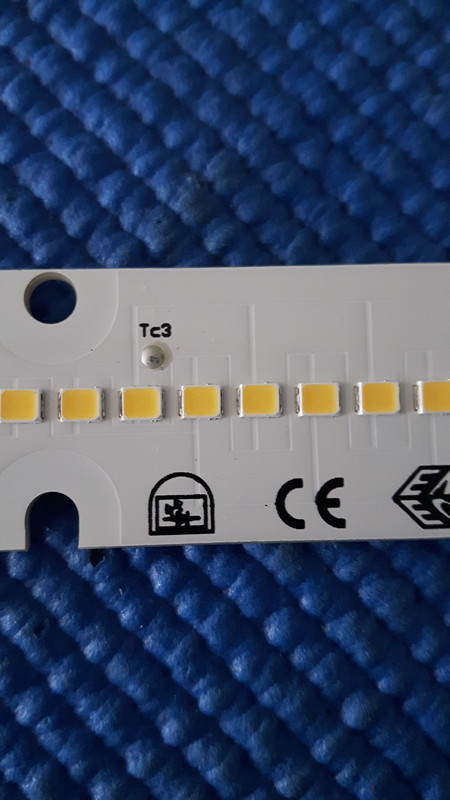
Is that where I beam my IR thermometer at?
Or am I supposed to solder a wire to it and plug it into my multimeter?
I don't want to be anywhere near the 85°C maximum and figure maybe 70°C?
Is my IR thermometer adequate?
And would I get an erroneous reading if I aimed it directly at the surface of the LED segments?
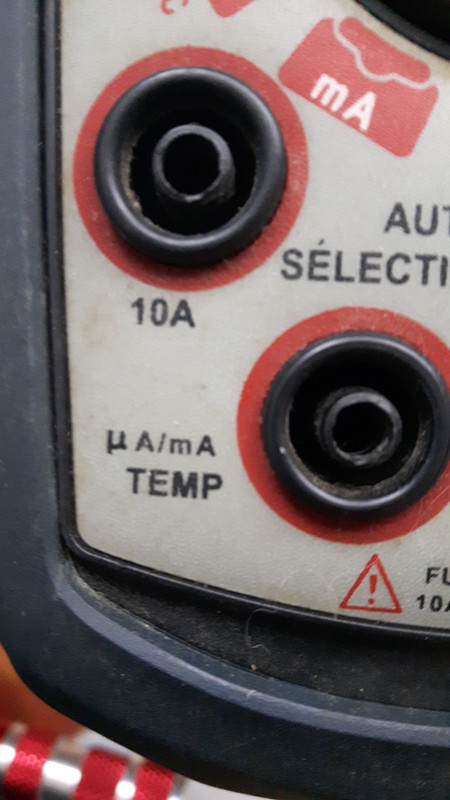
PCBuds
Well-known member
The tape is just double sided tape that is thermally conductive. Something like silver thermal paste that you would use in computers doesn’t have any “hold”.
I watched a video of a guy building an LED light using the tape.
He messed up a bit and had to peel a strip off and reposition it.
The tape is nice and sticky but he was able to peel the strip off with a bit of effort.
I figure the silicone glue would not allow for easy removal if need be.
PCBuds
Well-known member
Or is the strip itself a heatsink??
Yes, it is to an extent. If it's not turned up too bright it can radiate its heat off.
I just have to keep it below 85°C and I have no idea how bright it can be and stay below 85°.
The strips are rated 1000 lumens and I'm pretty sure that's at the test current of 350 mA.
The maximum current is 700 mA and it looks like the brightest goes up exponentially. (by looking at it anyway)
PCBuds
Well-known member
.. The great thing about science, is that it's based on substantiated facts, not beliefs.
I'm a bit confused what the argument is at this point, to be honest. Are you trying to argue against my point that not all 100CRI light spectrums are the same or are you arguing that PAR is obsolete science?
This is a quote from the led Gardner.

I have a hunch that grow lights should be a full spectrum that imitates the sun and that all plants make use of all frequencies of light.
Traditional grow lights have a red spike and a blue spike yet they are called "full-spectrum".


Full-spectrum to me means more like natural sunlight.
Where's the green output from our lights when the sun's output looks like this.

I have a hunch that we should introduce green light into our grow lights as well as far-infrared to allow the plant to utilize it.
I'm also arguing in general that diffused light from all sides is better than a single point source of light.
PCBuds
Well-known member
That sounds great. I like it. Not everyone wants to solder and connect wires however.
There is no soldering.
The wires just plug into reusable clips on the strips and the other ends go under screws on the power supply.
No worse than installing sockets for SILs.
I'm pretty sure the Meanwell drivers require connectors or soldering.


Hookahhead
Active member
I’m not sure if you’re familiar with the terms PAR and PPFD?
So even though the sun puts out one spectrum, plants utilize certain bands more effectively. This is due to absorption of photons by chlorophyll A and B, as well as secondary pigments (carotene, xanthophyll, pheophytins). This is pretty easy to test by hitting a leaf with various wavelengths and recording how much reflects back, but I don’t think I’ve ever seen a cannabis specific PAR chart. Here’s a good “generic” one indagroove recently posted in the SILs thread. As you can see, green light is definitely absorbed... just not at the same intensity as red or blue.

https://medium.com/@sabinedowner/the-ultimate-lighting-guide-for-cannabis-cultivation-cc60b22df835Photosynthetic Active Radiation
PAR stands for photosynthetic active radiation. PAR are the wavelengths of light that can be used in photosynthesis. PAR sensors can be used at different levels of the cannabis plant canopy if the grower wants to measure how much useful light is penetrating through the leaves. The measure used for PAR is watts per square meter (W/m2).
Photosynthetic Photon Flux Density
PAR tells growers the wavelength or color of photosynthetic light, but to describe the photon energy, or intensity of the light, another measure is needed. Photosynthetic photon flux density (PPFD) is expressed as μmol∙m-2∙s-1, which is micromoles per square meter per second. PPFD describes the number of energy particles (photons) in the photosynthetic active radiation (PAR) range that fall on a one square meter area in one second.
Low PPFD irradiance may limit photosynthesis at the leaf surface. High PPFD irradiance in excess of photosynthetic needs at the leaf surface may be a threat to plant metabolism. A 2010 study found that the most productive PPFD for cannabis is 1500–2000 μmol∙m-2∙s-1 with environmental conditions at 25–30°C with CO2 concentration elevated to 750 ppm. Under these indoor conditions photosynthesis in cannabis was optimized.
Lighting with intensities of 1500–2000 μmol∙m-2∙s-1 can draw a lot of electricity and be very expensive to run. Most growers will use light that is less intense and produces a good yield. Seedlings, clones, and mother plants can be successful with just 200 to 400 μmol∙m-2∙s-1 PPFD. For plants in the vegetative growth phase of cannabis 400 to 600 μmol∙m-2∙s-1 PPFD can be sufficient. Flowering plants will benefit from more intense light with 600 to 900 μmol∙m-2∙s-1 PPFD.
So even though the sun puts out one spectrum, plants utilize certain bands more effectively. This is due to absorption of photons by chlorophyll A and B, as well as secondary pigments (carotene, xanthophyll, pheophytins). This is pretty easy to test by hitting a leaf with various wavelengths and recording how much reflects back, but I don’t think I’ve ever seen a cannabis specific PAR chart. Here’s a good “generic” one indagroove recently posted in the SILs thread. As you can see, green light is definitely absorbed... just not at the same intensity as red or blue.

PCBuds
Well-known member
I’m not sure if you’re familiar with the terms PAR and PPFD?
Thank you.
PCBuds
Well-known member
PAR may have to be redefined.
In this video, Dr. Bruce Bugbee summarizes the dual effects of photon quality on photosynthesis and plant shape. Spectral quality has an enormous effect on shape, but the effect varies among species. Conversely, the effect of spectral quality on photosynthesis is nearly constant among species, but our definition of photosynthetic photons may need revision to include both far-red photons and UV photons between 360 and 400 nm.
VIDEO CONTENT
2:48 The nine cardinal parameters that affect plant growth
3:59 Summary of spectral effects: 30 years of Bruce's photobiology research on 1 slide.
8:31 How colors of light penetrate leaves
9:36 Efficiency of LEDs
13:00 Spectral Effects: blue photon fraction and yield of cannabis
16:54 Edges of photosynthetic radiation. Why our definition of photosynthetic photons may need a revision by adding far-red and UV. How our definition of photosynthetic photons is influenced by the Emmerson enhancement effect and the McCree curve.
In this video, Dr. Bruce Bugbee summarizes the dual effects of photon quality on photosynthesis and plant shape. Spectral quality has an enormous effect on shape, but the effect varies among species. Conversely, the effect of spectral quality on photosynthesis is nearly constant among species, but our definition of photosynthetic photons may need revision to include both far-red photons and UV photons between 360 and 400 nm.
VIDEO CONTENT
2:48 The nine cardinal parameters that affect plant growth
3:59 Summary of spectral effects: 30 years of Bruce's photobiology research on 1 slide.
8:31 How colors of light penetrate leaves
9:36 Efficiency of LEDs
13:00 Spectral Effects: blue photon fraction and yield of cannabis
16:54 Edges of photosynthetic radiation. Why our definition of photosynthetic photons may need a revision by adding far-red and UV. How our definition of photosynthetic photons is influenced by the Emmerson enhancement effect and the McCree curve.
There is no soldering.
The wires just plug into reusable clips on the strips and the other ends go under screws on the power supply.
No worse than installing sockets for SILs.
I'm pretty sure the Meanwell drivers require connectors or soldering.
[URL=https://i.postimg.cc/vT9c45Dw/20191115-143616.jpg]View Image[/url]
[URL=https://i.postimg.cc/3Rzkrt8Z/20191115-143527.jpg]View Image[/url]
That's pretty sweet, I like it. I may consider adding some similar strips like that in the future to my grow. I think I would want to include heat-sinks however. Call me paranoid, but I worry about fire, and to me a $10 sink is worth it to mitigate potential disaster.
PAR may have to be redefined.
In this video, Dr. Bruce Bugbee summarizes the dual effects of photon quality on photosynthesis and plant shape. Spectral quality has an enormous effect on shape, but the effect varies among species. Conversely, the effect of spectral quality on photosynthesis is nearly constant among species, but our definition of photosynthetic photons may need revision to include both far-red photons and UV photons between 360 and 400 nm.
VIDEO CONTENT
2:48 The nine cardinal parameters that affect plant growth
3:59 Summary of spectral effects: 30 years of Bruce's photobiology research on 1 slide.
8:31 How colors of light penetrate leaves
9:36 Efficiency of LEDs
13:00 Spectral Effects: blue photon fraction and yield of cannabis
16:54 Edges of photosynthetic radiation. Why our definition of photosynthetic photons may need a revision by adding far-red and UV. How our definition of photosynthetic photons is influenced by the Emmerson enhancement effect and the McCree curve.
Think about it tho. Why are plants green in CRI 100 light? It's because the green we see is the light that the plants reflect back to us, meaning it's light that the plant does not absorb. It's logical to conclude that the plant does not need an abundance of light frequencies which it can not absorb. I think you may be metaphorically chasing the dragon here.
PCBuds
Well-known member
That's pretty sweet, I like it. I may consider adding some similar strips like that in the future to my grow. I think I would want to include heat-sinks however. Call me paranoid, but I worry about fire, and to me a $10 sink is worth it to mitigate potential disaster.
Yeah, fire is my biggest concern too.
That's why I put the SIL in the coffee can full of dry leaves just to see if it would ignite, sort of a worst-case scenario.
The strips are rated to 85°C and I'm pretty sure they would just burn out beyond that temperature and not actually burn.
And I found this on the Google.

I can always add heat sinks at a later date.
Without them, I just won't be able to turn them up as bright.
My IR thermometer may not get here until late January and it's going to be my principal instrument.
The thermal tape may take just as long to get here.
I don't think I want to use the LED strips until I've got my thermometer.
Think about it tho. Why are plants green in CRI 100 light? It's because the green we see is the light that the plants reflect back to us, meaning it's light that the plant does not absorb. It's logical to conclude that the plant does not need an abundance of light frequencies which it can not absorb. I think you may be metaphorically chasing the dragon here.
In one of his videos, he talks about how far-infrared allows plants to absorb other colors.
But yeah, I'm just chasing my tail.
I bought the wrong infrared LEDs.
They're 840 nanometers and they're supposed to be 730 nanometers.
Oops. Lol
PCBuds
Well-known member
In one of his videos, he talks about how far-infrared allows plants to absorb other colors.
This video.
https://www.youtube.com/watch?v=sS7aAcacfgk
PCBuds
Well-known member
PCBuds
Well-known member
Why are plants green in CRI 100 light? It's because the green we see is the light that the plants reflect back to us, meaning it's light that the plant does not absorb...
In art class, if you mix red, green and blue, paint you get black.
But in physics class, if you mix red, green and blue light you get white.
If you take a white disk and sprinkle red, green and blue paint on it you see red, green and blue spots.
If you spin the disk, it appears white.
Hookahhead
Active member
In art class, if you mix red, green and blue, paint you get black.
But in physics class, if you mix red, green and blue light you get white.
If you take a white disk and sprinkle red, green and blue paint on it you see red, green and blue spots.
If you spin the disk, it appears white.
This is because of how humans perceive light. We have Red, Blue, and Green cones in our eyes that get excited by these wavelengths.
You can use a prism to split light into the rainbow of visible light. Therefore, white light is comprised of all the colors and this fully saturating our receptors.
Paints and dyes contain various pigments; molecules that absorb or reflect certain wavelengths of visible light. Therefore the pigments in blue paint only reflect light in the blue spectrum.. and thus appears blue to us.
https://www.livescience.com/32559-why-do-we-see-in-color.html
I can always add heat sinks at a later date.
Without them, I just won't be able to turn them up as bright.
...
In one of his videos, he talks about how far-infrared allows plants to absorb other colors.
But yeah, I'm just chasing my tail.
I bought the wrong infrared LEDs.
They're 840 nanometers and they're supposed to be 730 nanometers.
Oops. Lol
I haven't watched that video yet, but my initial thought is to wonder how much the extra absorption of other colors from exposure to far red really helps in photosynthesis? My concern would be the fed-red messing with flowering more than it helps with extra absorption. Might want to have far-red on a different timer, so it only activates 2 hrs before/after the dark periods.
As far as running the strips ar lower voltage, I think that is best for your lumen/watt ratings anyway. I briefly looked for info on the lm/current curve of the bridgelux diodes, but couldn't find anything. That's something that's great about the cree leds, they give good documentation in that regard.
In art class, if you mix red, green and blue, paint you get black.
But in physics class, if you mix red, green and blue light you get white.
If you take a white disk and sprinkle red, green and blue paint on it you see red, green and blue spots.
If you spin the disk, it appears white.
There are two different kinds of color mixing: additive or subtractive.
Here is a real world example of the two different types of color mixing used in real world applications, which most of us can relate to, rock concert lighting.
Rock concert lighting has come a long way in the past 50 years. First think of the old days of rock in the 70's and 80's with big light shows loaded up with hundreds of kilowatts from Par 64 cans. A par 64 is basically an old-school 1000w white car headlight in a can, powered by a 1.2kw dimmer. To get this white light into pretty rock colors there are colored filters which are placed in front of the lamp, which subtract the frequencies you don't want produced in the final color (ie: to get purple you remove the yellow and other non-purple hues).
Now a days, that same type of technology is still used, but more and more with LED concert lighting, we use an additive approach, in that the lamps contain various different colors of LED (typically RGB or CMY), which are mixed using DMX 512 protocols to add different levels of specific LEDs to produce the desired color.
It's interesting to see these two technologies side by side producing the same color by two opposite methods. Because of it's additive nature, traditionally dark colors like deep reds and purples "punch" harder with additive technology vs older subtractive technology.

